Fall 2019: MGT 4250 - Group Dynamics Critical Analysis Report
VerifiedAdded on 2021/10/18
|18
|2846
|158
Report
AI Summary
This report provides a critical analysis of group dynamics within the context of an organizational behavior course (MGT 4250). The analysis focuses on a specific group and applies two prominent models: Tuckman's Model on Team Development and the Punctuated Equilibrium Model. The report details the group's profile, reviews relevant literature on group dynamics, and presents the results of an online questionnaire administered to group members. It then applies the chosen models to assess the group's development and performance, highlighting the stages of forming, storming, norming, performing, and adjourning (Tuckman) and the phases of the Punctuated Equilibrium Model. The conclusion synthesizes the findings, emphasizing the group's effective communication, equal participation, and overall success in achieving its objectives. Recommendations for future group work are also provided. The assignment's content is valuable for students studying organizational behavior and leadership, as it offers insights into team dynamics and effective collaboration.
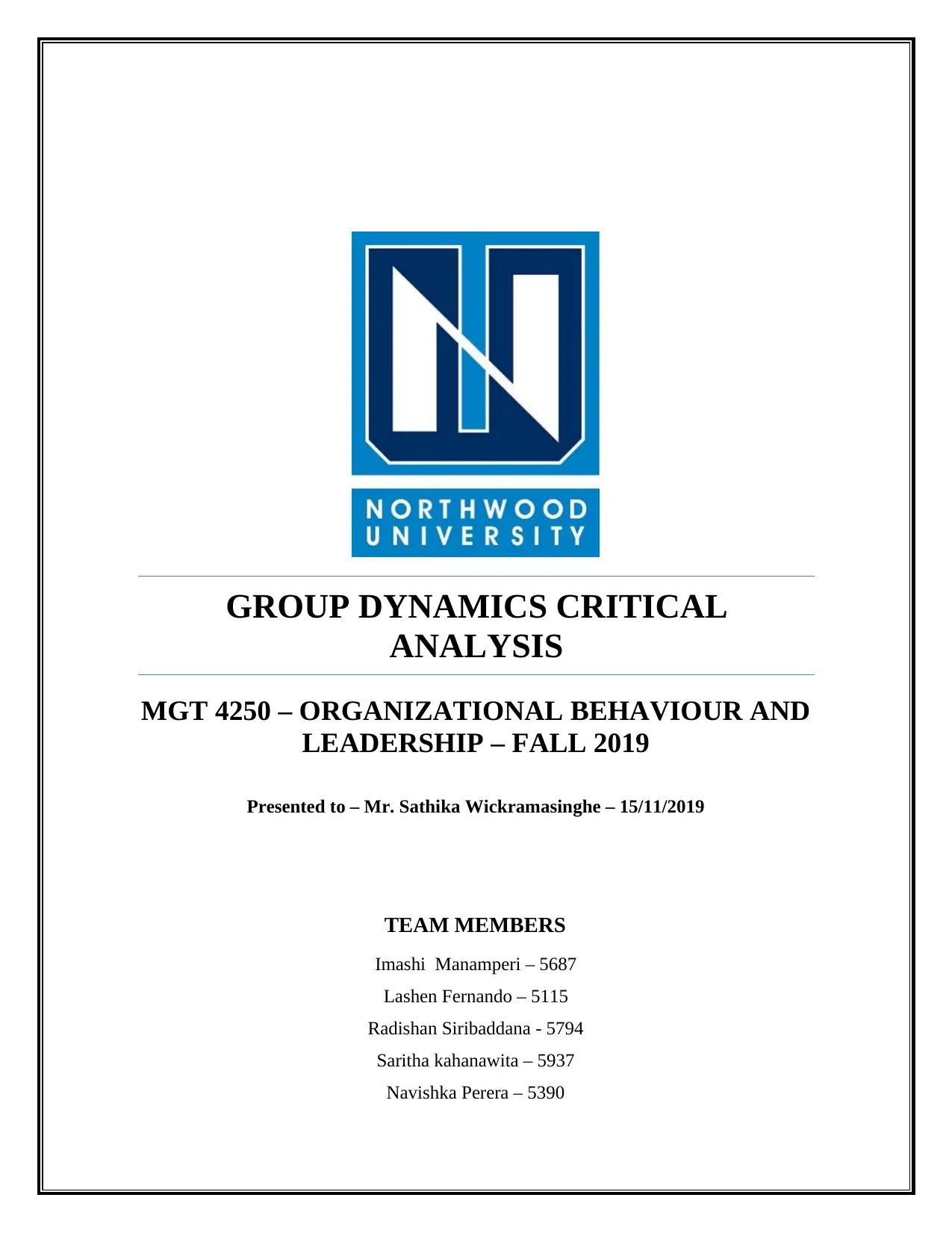
GROUP DYNAMICS CRITICAL
ANALYSIS
MGT 4250 – ORGANIZATIONAL BEHAVIOUR AND
LEADERSHIP – FALL 2019
Presented to – Mr. Sathika Wickramasinghe – 15/11/2019
TEAM MEMBERS
Imashi Manamperi – 5687
Lashen Fernando – 5115
Radishan Siribaddana - 5794
Saritha kahanawita – 5937
Navishka Perera – 5390
ANALYSIS
MGT 4250 – ORGANIZATIONAL BEHAVIOUR AND
LEADERSHIP – FALL 2019
Presented to – Mr. Sathika Wickramasinghe – 15/11/2019
TEAM MEMBERS
Imashi Manamperi – 5687
Lashen Fernando – 5115
Radishan Siribaddana - 5794
Saritha kahanawita – 5937
Navishka Perera – 5390
Paraphrase This Document
Need a fresh take? Get an instant paraphrase of this document with our AI Paraphraser
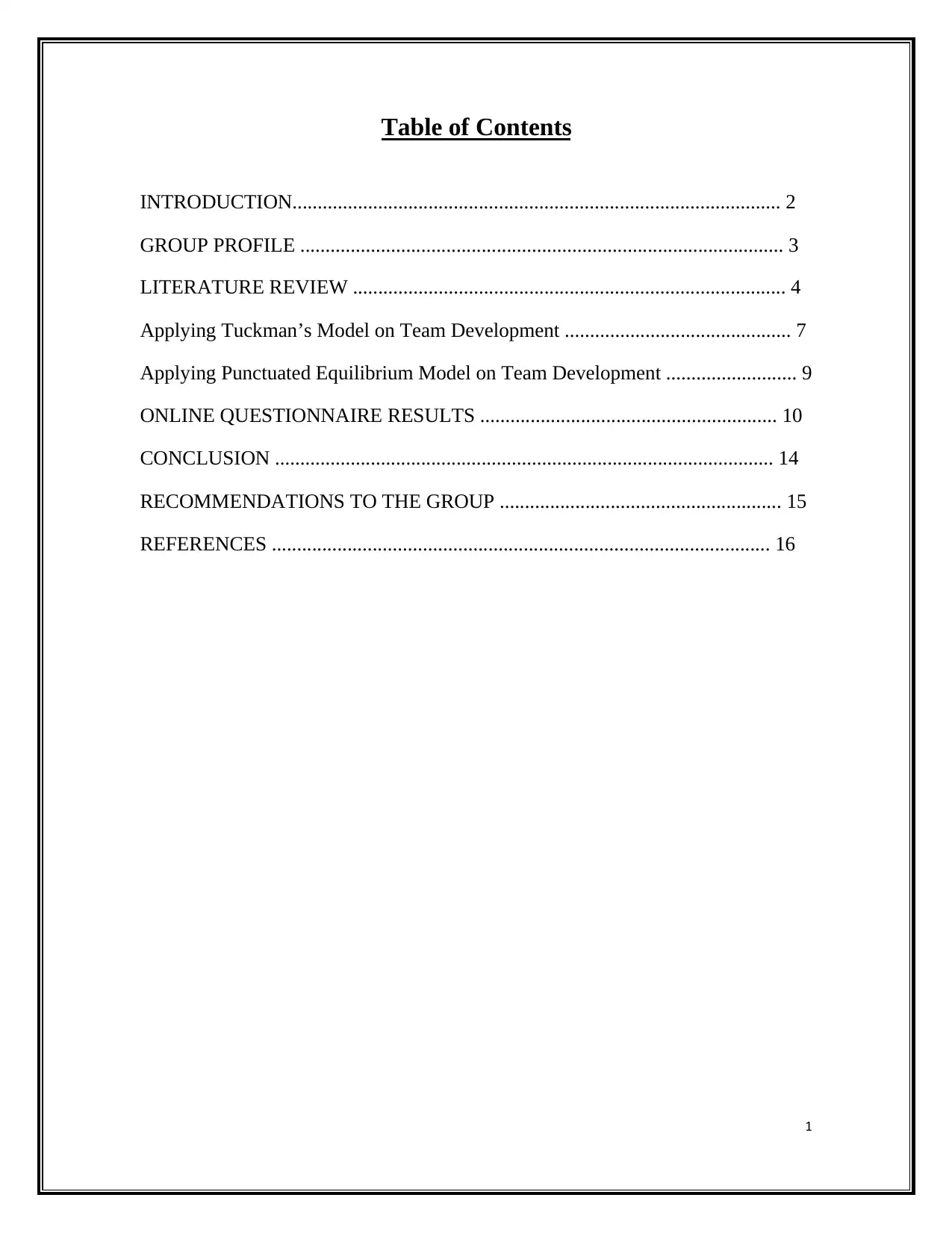
1
Table of Contents
INTRODUCTION................................................................................................. 2
GROUP PROFILE ................................................................................................ 3
LITERATURE REVIEW ...................................................................................... 4
Applying Tuckman’s Model on Team Development ............................................. 7
Applying Punctuated Equilibrium Model on Team Development .......................... 9
ONLINE QUESTIONNAIRE RESULTS ........................................................... 10
CONCLUSION ................................................................................................... 14
RECOMMENDATIONS TO THE GROUP ........................................................ 15
REFERENCES ................................................................................................... 16
Table of Contents
INTRODUCTION................................................................................................. 2
GROUP PROFILE ................................................................................................ 3
LITERATURE REVIEW ...................................................................................... 4
Applying Tuckman’s Model on Team Development ............................................. 7
Applying Punctuated Equilibrium Model on Team Development .......................... 9
ONLINE QUESTIONNAIRE RESULTS ........................................................... 10
CONCLUSION ................................................................................................... 14
RECOMMENDATIONS TO THE GROUP ........................................................ 15
REFERENCES ................................................................................................... 16
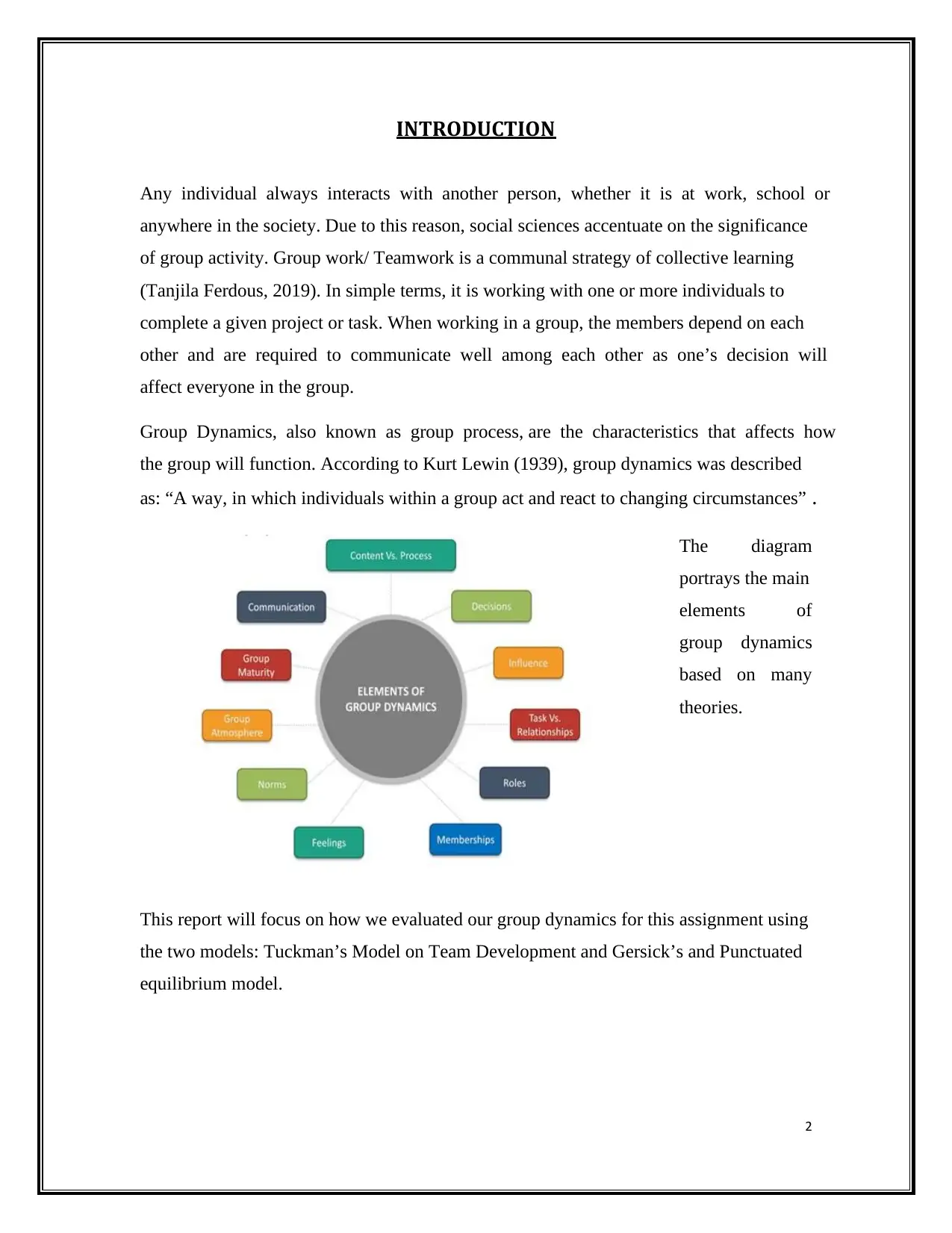
2
INTRODUCTION
Any individual always interacts with another person, whether it is at work, school or
anywhere in the society. Due to this reason, social sciences accentuate on the significance
of group activity. Group work/ Teamwork is a communal strategy of collective learning
(Tanjila Ferdous, 2019). In simple terms, it is working with one or more individuals to
complete a given project or task. When working in a group, the members depend on each
other and are required to communicate well among each other as one’s decision will
affect everyone in the group.
Group Dynamics, also known as group process, are the characteristics that affects how
the group will function. According to Kurt Lewin (1939), group dynamics was described
as: “A way, in which individuals within a group act and react to changing circumstances” .
The diagram
portrays the main
elements of
group dynamics
based on many
theories.
This report will focus on how we evaluated our group dynamics for this assignment using
the two models: Tuckman’s Model on Team Development and Gersick’s and Punctuated
equilibrium model.
INTRODUCTION
Any individual always interacts with another person, whether it is at work, school or
anywhere in the society. Due to this reason, social sciences accentuate on the significance
of group activity. Group work/ Teamwork is a communal strategy of collective learning
(Tanjila Ferdous, 2019). In simple terms, it is working with one or more individuals to
complete a given project or task. When working in a group, the members depend on each
other and are required to communicate well among each other as one’s decision will
affect everyone in the group.
Group Dynamics, also known as group process, are the characteristics that affects how
the group will function. According to Kurt Lewin (1939), group dynamics was described
as: “A way, in which individuals within a group act and react to changing circumstances” .
The diagram
portrays the main
elements of
group dynamics
based on many
theories.
This report will focus on how we evaluated our group dynamics for this assignment using
the two models: Tuckman’s Model on Team Development and Gersick’s and Punctuated
equilibrium model.
⊘ This is a preview!⊘
Do you want full access?
Subscribe today to unlock all pages.

Trusted by 1+ million students worldwide
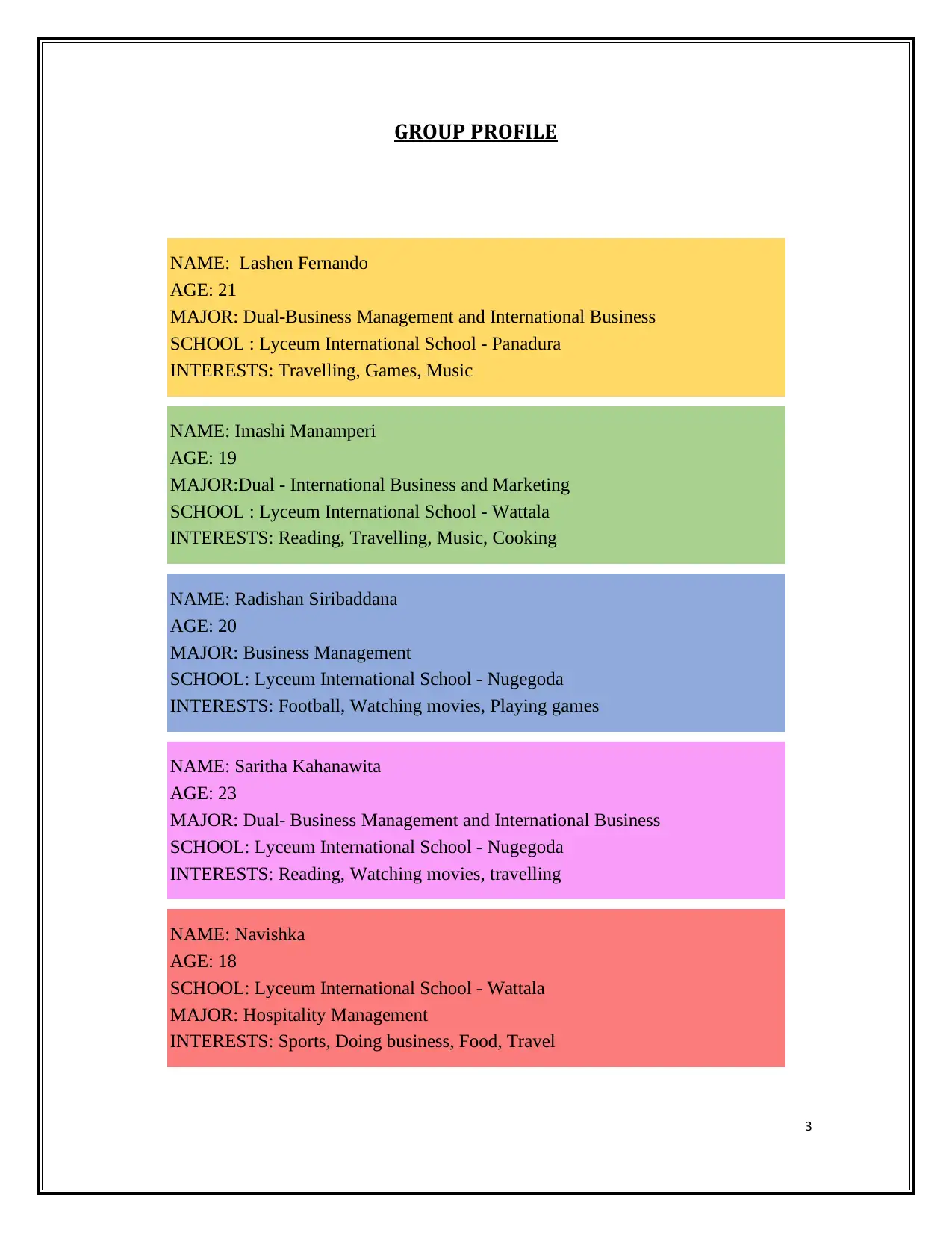
3
GROUP PROFILE
NAME: Lashen Fernando
AGE: 21
MAJOR: Dual-Business Management and International Business
SCHOOL : Lyceum International School - Panadura
INTERESTS: Travelling, Games, Music
NAME: Imashi Manamperi
AGE: 19
MAJOR:Dual - International Business and Marketing
SCHOOL : Lyceum International School - Wattala
INTERESTS: Reading, Travelling, Music, Cooking
NAME: Radishan Siribaddana
AGE: 20
MAJOR: Business Management
SCHOOL: Lyceum International School - Nugegoda
INTERESTS: Football, Watching movies, Playing games
NAME: Saritha Kahanawita
AGE: 23
MAJOR: Dual- Business Management and International Business
SCHOOL: Lyceum International School - Nugegoda
INTERESTS: Reading, Watching movies, travelling
NAME: Navishka
AGE: 18
SCHOOL: Lyceum International School - Wattala
MAJOR: Hospitality Management
INTERESTS: Sports, Doing business, Food, Travel
GROUP PROFILE
NAME: Lashen Fernando
AGE: 21
MAJOR: Dual-Business Management and International Business
SCHOOL : Lyceum International School - Panadura
INTERESTS: Travelling, Games, Music
NAME: Imashi Manamperi
AGE: 19
MAJOR:Dual - International Business and Marketing
SCHOOL : Lyceum International School - Wattala
INTERESTS: Reading, Travelling, Music, Cooking
NAME: Radishan Siribaddana
AGE: 20
MAJOR: Business Management
SCHOOL: Lyceum International School - Nugegoda
INTERESTS: Football, Watching movies, Playing games
NAME: Saritha Kahanawita
AGE: 23
MAJOR: Dual- Business Management and International Business
SCHOOL: Lyceum International School - Nugegoda
INTERESTS: Reading, Watching movies, travelling
NAME: Navishka
AGE: 18
SCHOOL: Lyceum International School - Wattala
MAJOR: Hospitality Management
INTERESTS: Sports, Doing business, Food, Travel
Paraphrase This Document
Need a fresh take? Get an instant paraphrase of this document with our AI Paraphraser
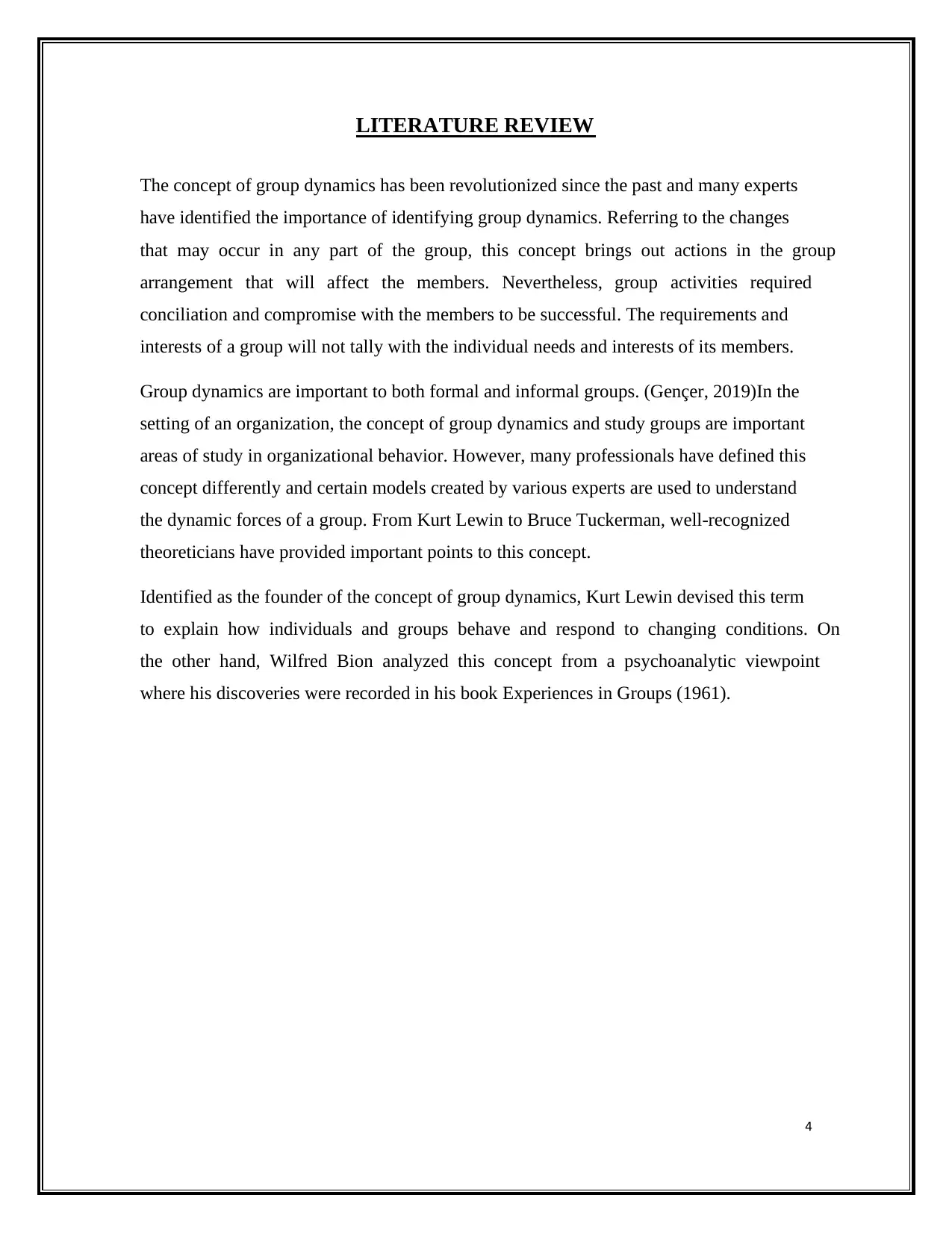
4
LITERATURE REVIEW
The concept of group dynamics has been revolutionized since the past and many experts
have identified the importance of identifying group dynamics. Referring to the changes
that may occur in any part of the group, this concept brings out actions in the group
arrangement that will affect the members. Nevertheless, group activities required
conciliation and compromise with the members to be successful. The requirements and
interests of a group will not tally with the individual needs and interests of its members.
Group dynamics are important to both formal and informal groups. (Gençer, 2019)In the
setting of an organization, the concept of group dynamics and study groups are important
areas of study in organizational behavior. However, many professionals have defined this
concept differently and certain models created by various experts are used to understand
the dynamic forces of a group. From Kurt Lewin to Bruce Tuckerman, well-recognized
theoreticians have provided important points to this concept.
Identified as the founder of the concept of group dynamics, Kurt Lewin devised this term
to explain how individuals and groups behave and respond to changing conditions. On
the other hand, Wilfred Bion analyzed this concept from a psychoanalytic viewpoint
where his discoveries were recorded in his book Experiences in Groups (1961).
LITERATURE REVIEW
The concept of group dynamics has been revolutionized since the past and many experts
have identified the importance of identifying group dynamics. Referring to the changes
that may occur in any part of the group, this concept brings out actions in the group
arrangement that will affect the members. Nevertheless, group activities required
conciliation and compromise with the members to be successful. The requirements and
interests of a group will not tally with the individual needs and interests of its members.
Group dynamics are important to both formal and informal groups. (Gençer, 2019)In the
setting of an organization, the concept of group dynamics and study groups are important
areas of study in organizational behavior. However, many professionals have defined this
concept differently and certain models created by various experts are used to understand
the dynamic forces of a group. From Kurt Lewin to Bruce Tuckerman, well-recognized
theoreticians have provided important points to this concept.
Identified as the founder of the concept of group dynamics, Kurt Lewin devised this term
to explain how individuals and groups behave and respond to changing conditions. On
the other hand, Wilfred Bion analyzed this concept from a psychoanalytic viewpoint
where his discoveries were recorded in his book Experiences in Groups (1961).
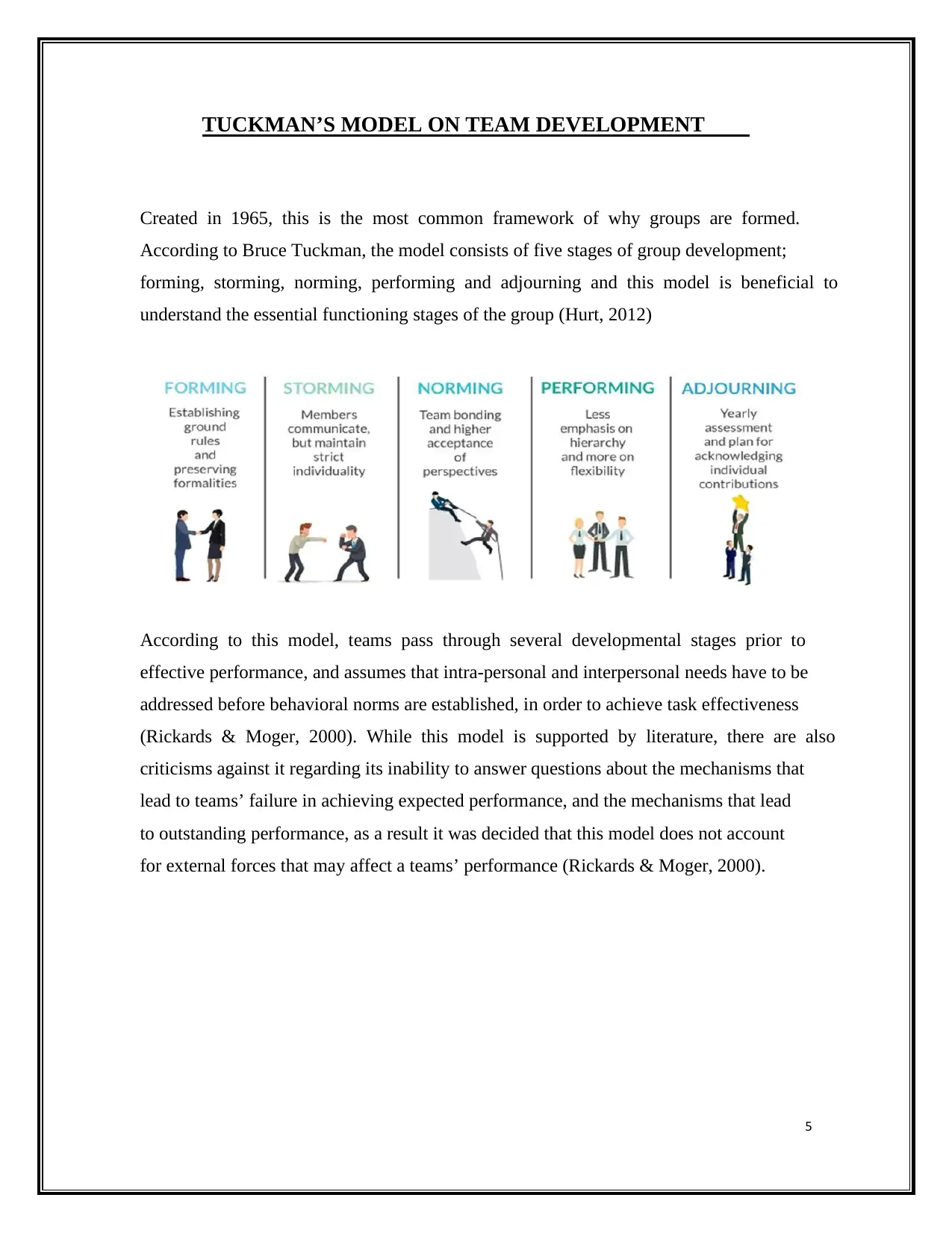
5
TUCKMAN’S MODEL ON TEAM DEVELOPMENT
Created in 1965, this is the most common framework of why groups are formed.
According to Bruce Tuckman, the model consists of five stages of group development;
forming, storming, norming, performing and adjourning and this model is beneficial to
understand the essential functioning stages of the group (Hurt, 2012)
According to this model, teams pass through several developmental stages prior to
effective performance, and assumes that intra-personal and interpersonal needs have to be
addressed before behavioral norms are established, in order to achieve task effectiveness
(Rickards & Moger, 2000). While this model is supported by literature, there are also
criticisms against it regarding its inability to answer questions about the mechanisms that
lead to teams’ failure in achieving expected performance, and the mechanisms that lead
to outstanding performance, as a result it was decided that this model does not account
for external forces that may affect a teams’ performance (Rickards & Moger, 2000).
TUCKMAN’S MODEL ON TEAM DEVELOPMENT
Created in 1965, this is the most common framework of why groups are formed.
According to Bruce Tuckman, the model consists of five stages of group development;
forming, storming, norming, performing and adjourning and this model is beneficial to
understand the essential functioning stages of the group (Hurt, 2012)
According to this model, teams pass through several developmental stages prior to
effective performance, and assumes that intra-personal and interpersonal needs have to be
addressed before behavioral norms are established, in order to achieve task effectiveness
(Rickards & Moger, 2000). While this model is supported by literature, there are also
criticisms against it regarding its inability to answer questions about the mechanisms that
lead to teams’ failure in achieving expected performance, and the mechanisms that lead
to outstanding performance, as a result it was decided that this model does not account
for external forces that may affect a teams’ performance (Rickards & Moger, 2000).
⊘ This is a preview!⊘
Do you want full access?
Subscribe today to unlock all pages.

Trusted by 1+ million students worldwide
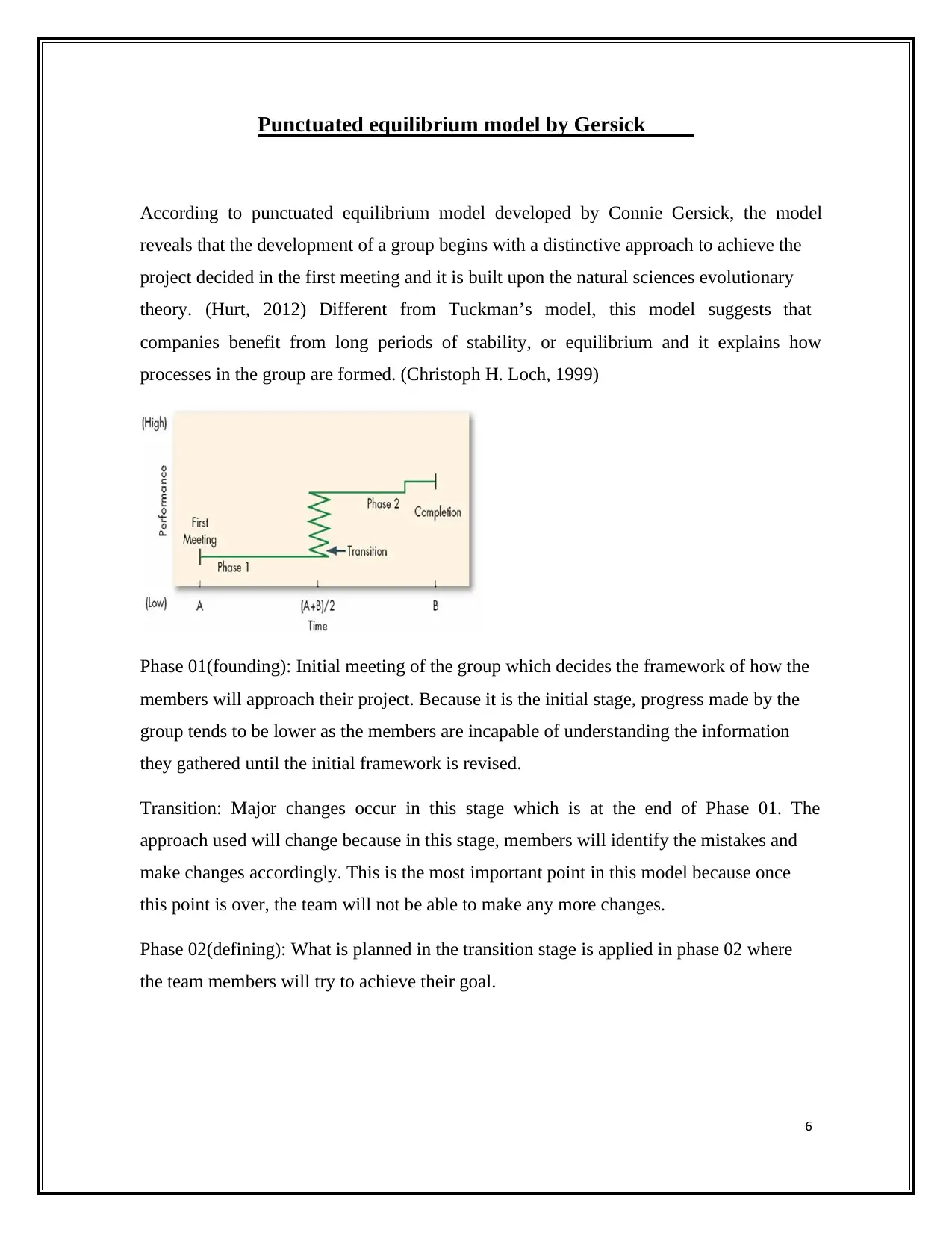
6
Punctuated equilibrium model by Gersick
According to punctuated equilibrium model developed by Connie Gersick, the model
reveals that the development of a group begins with a distinctive approach to achieve the
project decided in the first meeting and it is built upon the natural sciences evolutionary
theory. (Hurt, 2012) Different from Tuckman’s model, this model suggests that
companies benefit from long periods of stability, or equilibrium and it explains how
processes in the group are formed. (Christoph H. Loch, 1999)
Phase 01(founding): Initial meeting of the group which decides the framework of how the
members will approach their project. Because it is the initial stage, progress made by the
group tends to be lower as the members are incapable of understanding the information
they gathered until the initial framework is revised.
Transition: Major changes occur in this stage which is at the end of Phase 01. The
approach used will change because in this stage, members will identify the mistakes and
make changes accordingly. This is the most important point in this model because once
this point is over, the team will not be able to make any more changes.
Phase 02(defining): What is planned in the transition stage is applied in phase 02 where
the team members will try to achieve their goal.
Punctuated equilibrium model by Gersick
According to punctuated equilibrium model developed by Connie Gersick, the model
reveals that the development of a group begins with a distinctive approach to achieve the
project decided in the first meeting and it is built upon the natural sciences evolutionary
theory. (Hurt, 2012) Different from Tuckman’s model, this model suggests that
companies benefit from long periods of stability, or equilibrium and it explains how
processes in the group are formed. (Christoph H. Loch, 1999)
Phase 01(founding): Initial meeting of the group which decides the framework of how the
members will approach their project. Because it is the initial stage, progress made by the
group tends to be lower as the members are incapable of understanding the information
they gathered until the initial framework is revised.
Transition: Major changes occur in this stage which is at the end of Phase 01. The
approach used will change because in this stage, members will identify the mistakes and
make changes accordingly. This is the most important point in this model because once
this point is over, the team will not be able to make any more changes.
Phase 02(defining): What is planned in the transition stage is applied in phase 02 where
the team members will try to achieve their goal.
Paraphrase This Document
Need a fresh take? Get an instant paraphrase of this document with our AI Paraphraser
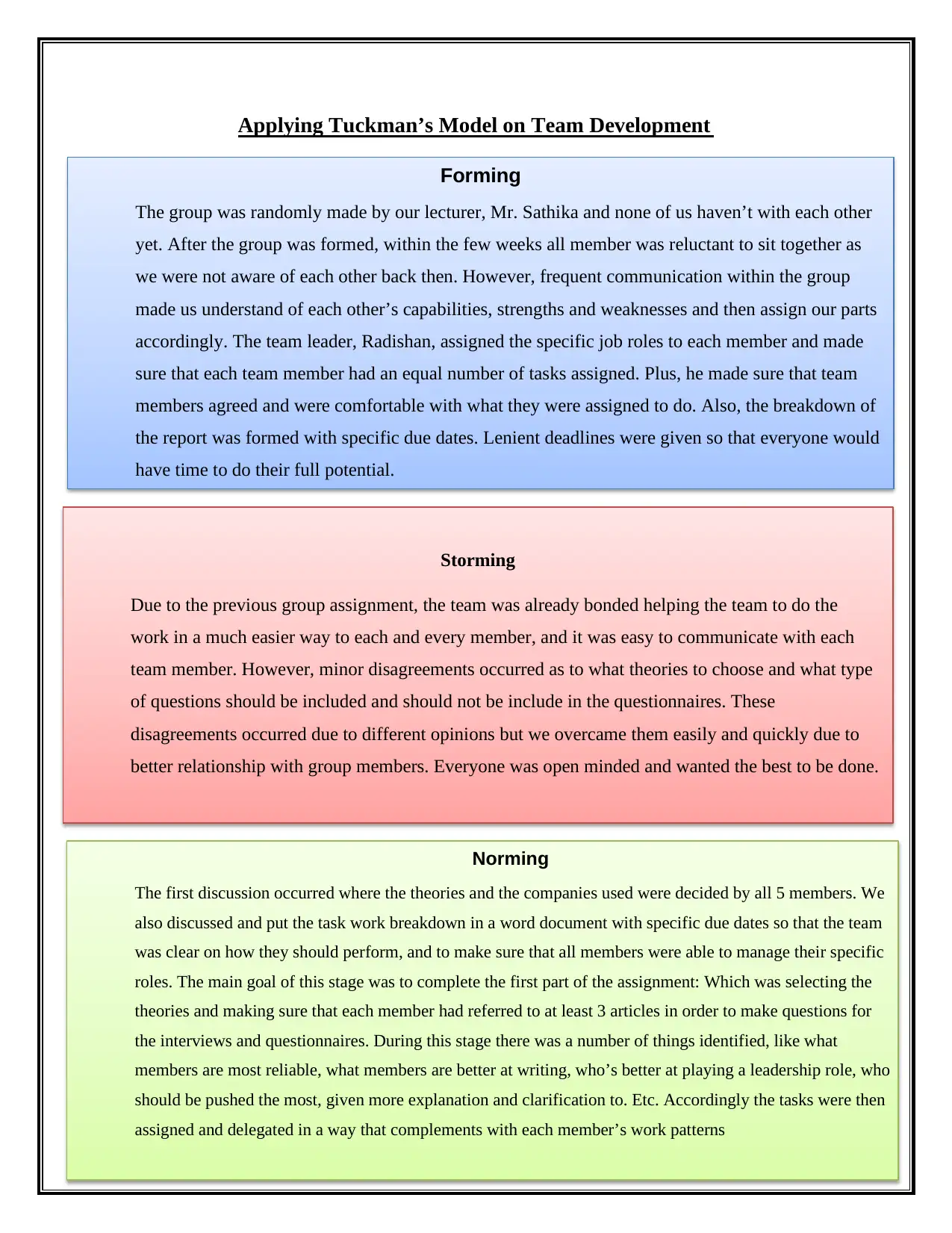
7
Applying Tuckman’s Model on Team Development
Forming
The group was randomly made by our lecturer, Mr. Sathika and none of us haven’t with each other
yet. After the group was formed, within the few weeks all member was reluctant to sit together as
we were not aware of each other back then. However, frequent communication within the group
made us understand of each other’s capabilities, strengths and weaknesses and then assign our parts
accordingly. The team leader, Radishan, assigned the specific job roles to each member and made
sure that each team member had an equal number of tasks assigned. Plus, he made sure that team
members agreed and were comfortable with what they were assigned to do. Also, the breakdown of
the report was formed with specific due dates. Lenient deadlines were given so that everyone would
have time to do their full potential.
Storming
Due to the previous group assignment, the team was already bonded helping the team to do the
work in a much easier way to each and every member, and it was easy to communicate with each
team member. However, minor disagreements occurred as to what theories to choose and what type
of questions should be included and should not be include in the questionnaires. These
disagreements occurred due to different opinions but we overcame them easily and quickly due to
better relationship with group members. Everyone was open minded and wanted the best to be done.
Norming
The first discussion occurred where the theories and the companies used were decided by all 5 members. We
also discussed and put the task work breakdown in a word document with specific due dates so that the team
was clear on how they should perform, and to make sure that all members were able to manage their specific
roles. The main goal of this stage was to complete the first part of the assignment: Which was selecting the
theories and making sure that each member had referred to at least 3 articles in order to make questions for
the interviews and questionnaires. During this stage there was a number of things identified, like what
members are most reliable, what members are better at writing, who’s better at playing a leadership role, who
should be pushed the most, given more explanation and clarification to. Etc. Accordingly the tasks were then
assigned and delegated in a way that complements with each member’s work patterns
Applying Tuckman’s Model on Team Development
Forming
The group was randomly made by our lecturer, Mr. Sathika and none of us haven’t with each other
yet. After the group was formed, within the few weeks all member was reluctant to sit together as
we were not aware of each other back then. However, frequent communication within the group
made us understand of each other’s capabilities, strengths and weaknesses and then assign our parts
accordingly. The team leader, Radishan, assigned the specific job roles to each member and made
sure that each team member had an equal number of tasks assigned. Plus, he made sure that team
members agreed and were comfortable with what they were assigned to do. Also, the breakdown of
the report was formed with specific due dates. Lenient deadlines were given so that everyone would
have time to do their full potential.
Storming
Due to the previous group assignment, the team was already bonded helping the team to do the
work in a much easier way to each and every member, and it was easy to communicate with each
team member. However, minor disagreements occurred as to what theories to choose and what type
of questions should be included and should not be include in the questionnaires. These
disagreements occurred due to different opinions but we overcame them easily and quickly due to
better relationship with group members. Everyone was open minded and wanted the best to be done.
Norming
The first discussion occurred where the theories and the companies used were decided by all 5 members. We
also discussed and put the task work breakdown in a word document with specific due dates so that the team
was clear on how they should perform, and to make sure that all members were able to manage their specific
roles. The main goal of this stage was to complete the first part of the assignment: Which was selecting the
theories and making sure that each member had referred to at least 3 articles in order to make questions for
the interviews and questionnaires. During this stage there was a number of things identified, like what
members are most reliable, what members are better at writing, who’s better at playing a leadership role, who
should be pushed the most, given more explanation and clarification to. Etc. Accordingly the tasks were then
assigned and delegated in a way that complements with each member’s work patterns
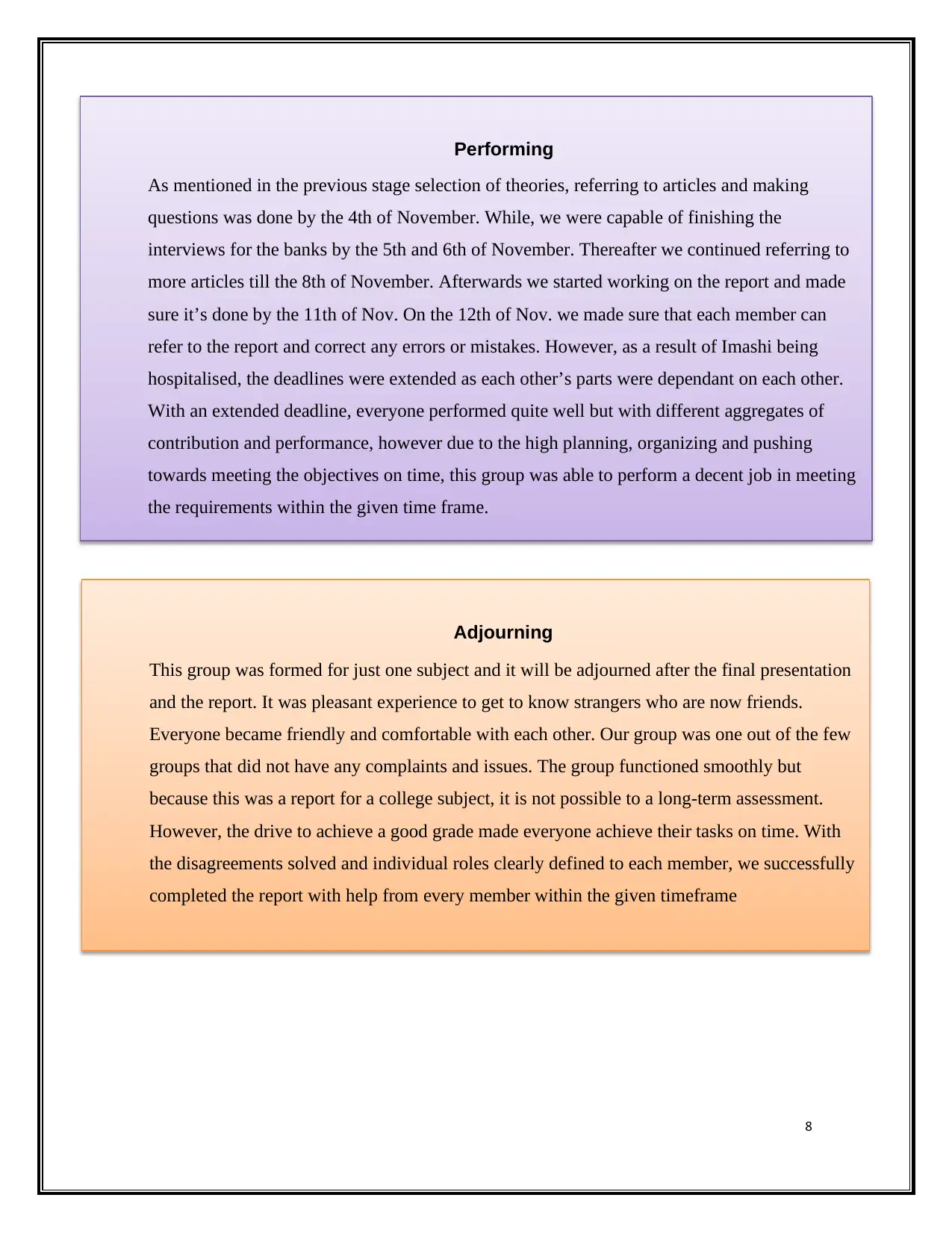
8
Performing
As mentioned in the previous stage selection of theories, referring to articles and making
questions was done by the 4th of November. While, we were capable of finishing the
interviews for the banks by the 5th and 6th of November. Thereafter we continued referring to
more articles till the 8th of November. Afterwards we started working on the report and made
sure it’s done by the 11th of Nov. On the 12th of Nov. we made sure that each member can
refer to the report and correct any errors or mistakes. However, as a result of Imashi being
hospitalised, the deadlines were extended as each other’s parts were dependant on each other.
With an extended deadline, everyone performed quite well but with different aggregates of
contribution and performance, however due to the high planning, organizing and pushing
towards meeting the objectives on time, this group was able to perform a decent job in meeting
the requirements within the given time frame.
Adjourning
This group was formed for just one subject and it will be adjourned after the final presentation
and the report. It was pleasant experience to get to know strangers who are now friends.
Everyone became friendly and comfortable with each other. Our group was one out of the few
groups that did not have any complaints and issues. The group functioned smoothly but
because this was a report for a college subject, it is not possible to a long-term assessment.
However, the drive to achieve a good grade made everyone achieve their tasks on time. With
the disagreements solved and individual roles clearly defined to each member, we successfully
completed the report with help from every member within the given timeframe
Performing
As mentioned in the previous stage selection of theories, referring to articles and making
questions was done by the 4th of November. While, we were capable of finishing the
interviews for the banks by the 5th and 6th of November. Thereafter we continued referring to
more articles till the 8th of November. Afterwards we started working on the report and made
sure it’s done by the 11th of Nov. On the 12th of Nov. we made sure that each member can
refer to the report and correct any errors or mistakes. However, as a result of Imashi being
hospitalised, the deadlines were extended as each other’s parts were dependant on each other.
With an extended deadline, everyone performed quite well but with different aggregates of
contribution and performance, however due to the high planning, organizing and pushing
towards meeting the objectives on time, this group was able to perform a decent job in meeting
the requirements within the given time frame.
Adjourning
This group was formed for just one subject and it will be adjourned after the final presentation
and the report. It was pleasant experience to get to know strangers who are now friends.
Everyone became friendly and comfortable with each other. Our group was one out of the few
groups that did not have any complaints and issues. The group functioned smoothly but
because this was a report for a college subject, it is not possible to a long-term assessment.
However, the drive to achieve a good grade made everyone achieve their tasks on time. With
the disagreements solved and individual roles clearly defined to each member, we successfully
completed the report with help from every member within the given timeframe
⊘ This is a preview!⊘
Do you want full access?
Subscribe today to unlock all pages.

Trusted by 1+ million students worldwide
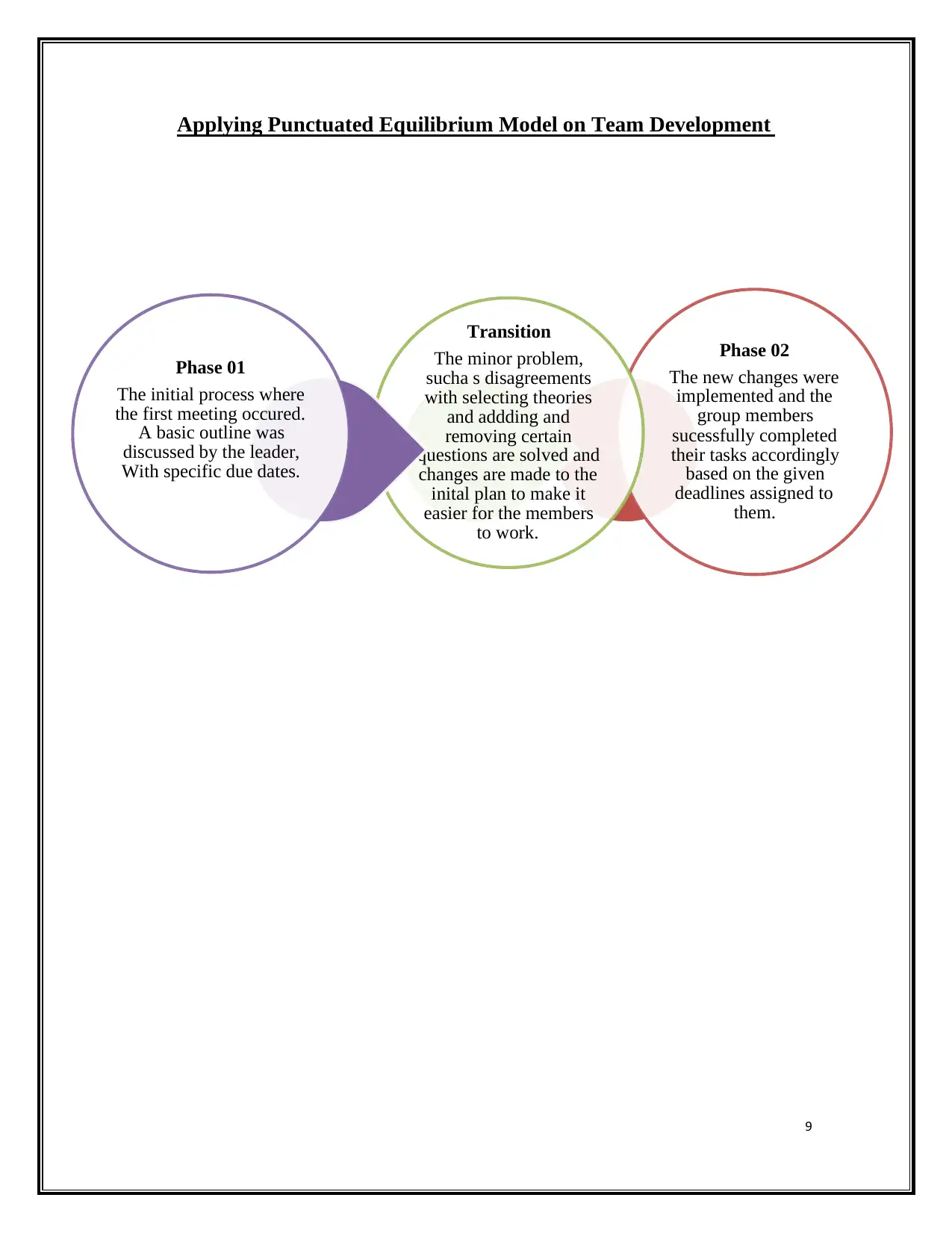
9
Phase 02
The new changes were
implemented and the
group members
sucessfully completed
their tasks accordingly
based on the given
deadlines assigned to
them.
Transition
The minor problem,
sucha s disagreements
with selecting theories
and addding and
removing certain
questions are solved and
changes are made to the
inital plan to make it
easier for the members
to work.
Phase 01
The initial process where
the first meeting occured.
A basic outline was
discussed by the leader,
With specific due dates.
Applying Punctuated Equilibrium Model on Team Development
Phase 02
The new changes were
implemented and the
group members
sucessfully completed
their tasks accordingly
based on the given
deadlines assigned to
them.
Transition
The minor problem,
sucha s disagreements
with selecting theories
and addding and
removing certain
questions are solved and
changes are made to the
inital plan to make it
easier for the members
to work.
Phase 01
The initial process where
the first meeting occured.
A basic outline was
discussed by the leader,
With specific due dates.
Applying Punctuated Equilibrium Model on Team Development
Paraphrase This Document
Need a fresh take? Get an instant paraphrase of this document with our AI Paraphraser
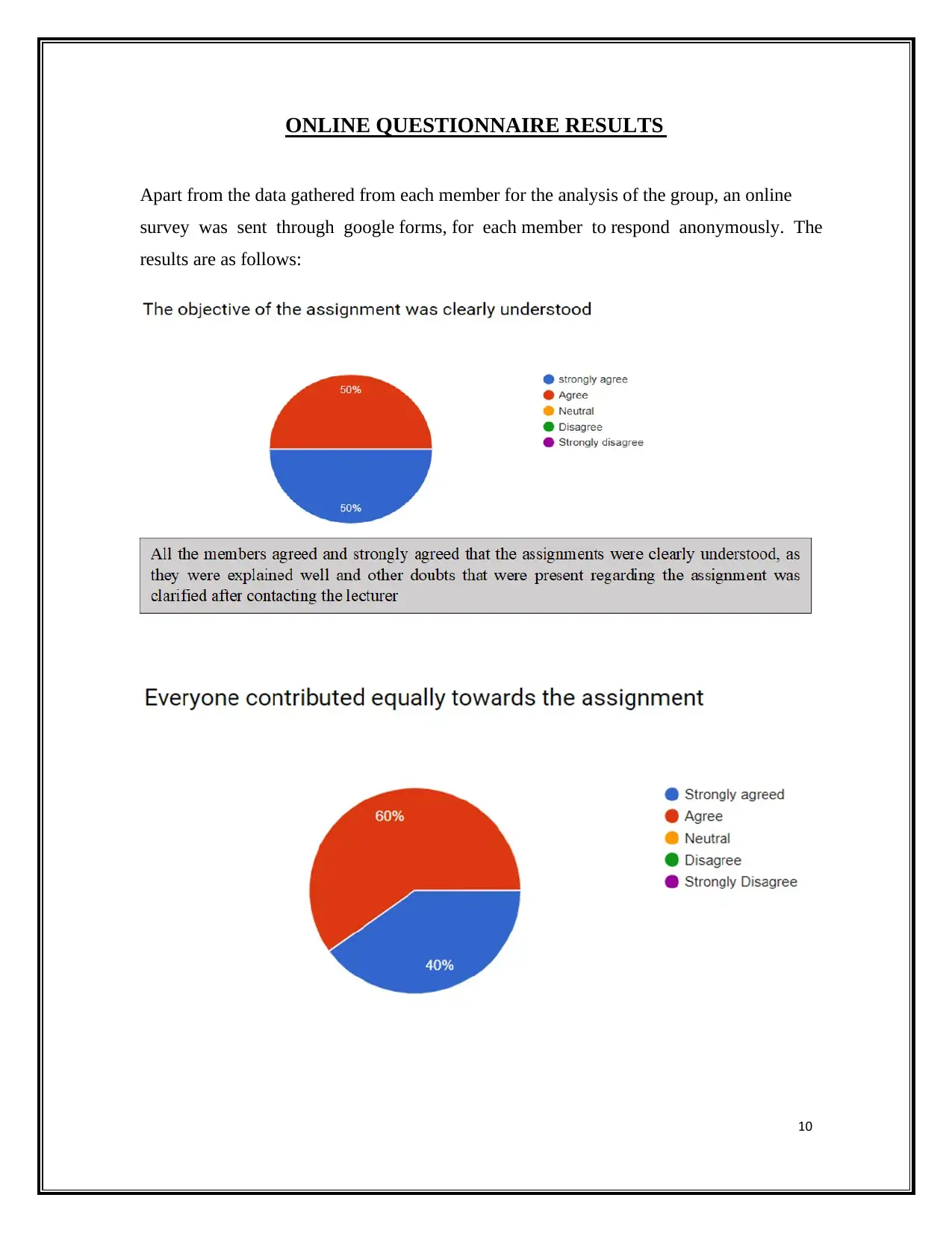
10
ONLINE QUESTIONNAIRE RESULTS
Apart from the data gathered from each member for the analysis of the group, an online
survey was sent through google forms, for each member to respond anonymously. The
results are as follows:
ONLINE QUESTIONNAIRE RESULTS
Apart from the data gathered from each member for the analysis of the group, an online
survey was sent through google forms, for each member to respond anonymously. The
results are as follows:
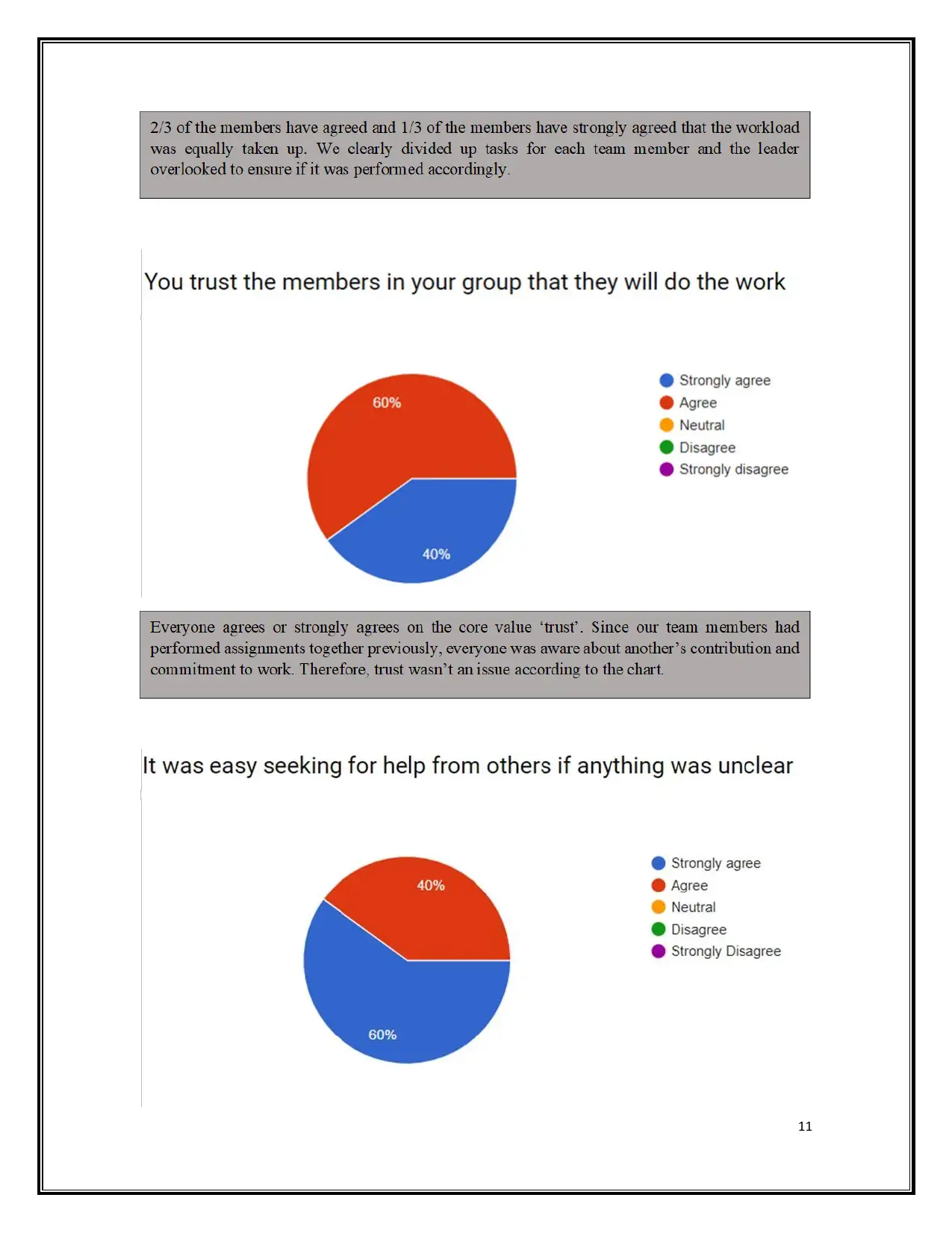
11
⊘ This is a preview!⊘
Do you want full access?
Subscribe today to unlock all pages.

Trusted by 1+ million students worldwide
1 out of 18
Your All-in-One AI-Powered Toolkit for Academic Success.
+13062052269
info@desklib.com
Available 24*7 on WhatsApp / Email
![[object Object]](/_next/static/media/star-bottom.7253800d.svg)
Unlock your academic potential
Copyright © 2020–2025 A2Z Services. All Rights Reserved. Developed and managed by ZUCOL.